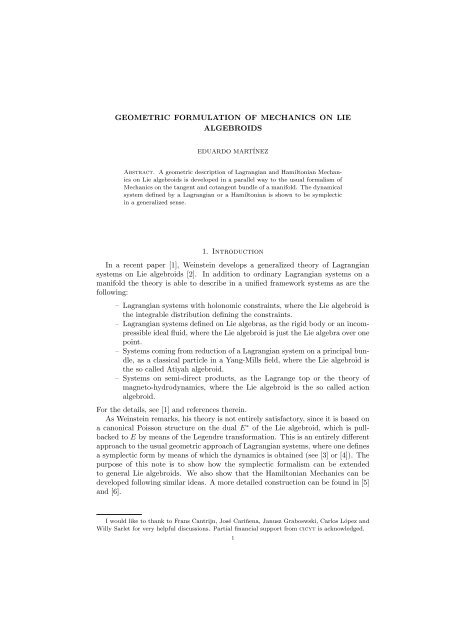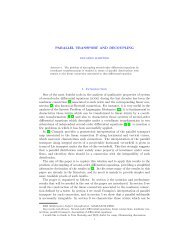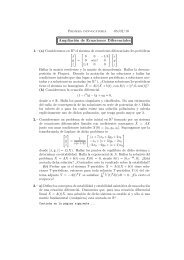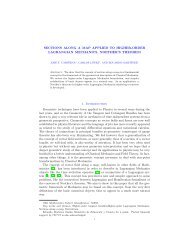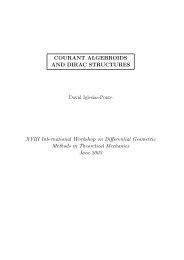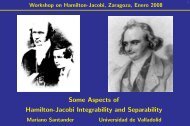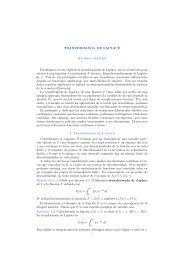GEOMETRIC FORMULATION OF MECHANICS ON LIE ...
GEOMETRIC FORMULATION OF MECHANICS ON LIE ...
GEOMETRIC FORMULATION OF MECHANICS ON LIE ...
You also want an ePaper? Increase the reach of your titles
YUMPU automatically turns print PDFs into web optimized ePapers that Google loves.
<strong>GEOMETRIC</strong> <strong>FORMULATI<strong>ON</strong></strong> <strong>OF</strong> <strong>MECHANICS</strong> <strong>ON</strong> <strong>LIE</strong> ALGEBROIDS 5It is easy to see that complete and vertical lifts satisfy the relations[σ V , η V ] = 0 [σ V , η C ] = [σ, η] V [σ C , η C ] = [σ, η] C ,for σ, η ∈ Sec(E). In fact, this relations are equivalent to the definition of thebracket given above.4. Geometry of T E EIn addition to the basic constructions explained in the last section, there areother important geometrical objects on T E E. This are the Liouville section, thevertical endomorphism and second-order differential equations.The Liouville section. The Liouville section ∆ is the section of τ 1 whose valueat the point a is the vertical lift to the point a of a itself, that is,∆(a) = ξ V (a, a) = (a, 0, a V a ).The coordinate expressions of ∆ and ρ 1 (∆) are∆ = y α V α ρ 1 (∆) = y α ∂∂y α .The vertical endomorphism. The vertical endomorphism S is the endomorphismof the bundle τ 1 : T E E → E defined by projection followed by vertical liftingS(a, b, v) = (a, 0, b V a ). The local expression of S isS = V α ⊗ X α ,where {X α , V α } is the dual base of {X α , V α }.The vertical endomorphism satisfies the following properties• S(σ V ) = 0 and S(σ C ) = σ V• S 2 = 0.• Im S = Ker S = Ver(T E E)• The Nijenhuis torsion of S vanishes.Second-order differential equations. In the case E = T M a second-orderdifferential equation on a manifold M is a vectorfield Γ on T M such that theirintegral curves are the natural prolongation of curves on the base manifold M.In the case of a general Lie algebroid the notion that replaces that of naturalprolongation is the notion of admissible curve.A tangent vector v to E at a point a is called admissible if T a τ(v) = ρ(a). Inother words, v is admissible if and only if (a, a, v) is in T E E. The set of admissibleelements of T E E will be denotes by Adm(E). A curve in E is admissible if itstangent vector is admissible at every point. A second-order differential equation(sode) on a Lie algebroid E is a section of T E E which takes values on Adm(E).It is easy to prove that Γ is a sode on E if and only if τ 2 ◦ Γ = id E if and only ifS(Γ) = ∆.In local coordinates, the expression of Γ and ρ 1 (Γ) areΓ(x, y) = y α X α + f α (x, y)V α ρ 1 (Γ) = ρ i αy α ∂∂x i + f α ∂∂y α .The integral curves of the sode Γ, i. e. the integral curves of ρ 1 (Γ), are the solutionsof the differential equationsdx idt = ρi α(x)y αdy αdt= f α (x, y).
6 EDUARDO MARTÍNEZNotice that the name sode must be used with care since the differential equationof its integral curves are not really second-order.5. Lagrangian systemsVariational principle. Let m 0 and m 1 be two points in the manifold M. Givena Lagrangian L ∈ C ∞ (E) we look for the critical points of the functionJ(η) =∫ baL(η(t)) dton the set of admisible curves η : [t 0 , t 1 ] → E such that γ(t 0 ) = m 0 and γ(t 1 ) = m 1for some fixed t 0 , t 1 ∈ R, and where γ(t) = τ(η(t)).We consider admissible variations η s (t) of the actual solution η 0 (t), and we denoteby γ s (t) = τ(η s (t)) the projection to M. The infinitesimal variation Z(t) =dη s (t)/ds ∣ s=0and its projection X(t) = dγ s (t)/ds ∣ s=0must satisfy the differentialequationdX i= y α ∂ρi α∂x j Xj + ρ i αZ α ,dttogether with the boundary conditions X(t 0 ) = X(t 1 ) = 0.Since the above boundary value problem is difficult to solve, we will consideronly a special kind of variations which will be enough for our purposes. For everysection σ of E such that σ(m 0 ) = σ(m 1 ) = 0 we set Z(t) = ρ 1 (σ C (η 0 (t))), andtherefore X(t) = ρ(σ(γ 0 (t))). Then Z satisfies the specified conditions and thevariation of J along Z isd∫ t1∫ t1∫ds J(η s) ∣ = Z(t)L dt = (ρ(σ C )L)(η 0 (t)) dt = d σ C L.s=0 t 0 t 0 η 0Taking into account the local expression of a complete lift, we have{d σ C L = ρ i ∂Lα∂x i − d ( )} ∂Ldt ∂y α − C γ ∂Lαβyβ ∂y γ σ α + d ( ) ∂Ldt ∂y α σα ,from where it follows that the curve η 0 is a solution of the Euler-Lagrange equationsdx i( )dt = ρi αy α d ∂Ldt ∂y α = ρ i ∂Lα∂x i − ∂LCγ αβyβ ∂y γ .The Lagrangian L is said to be regular if the Euler-Lagrange equations can bewritten in normal form. It is easy to see that L is regular if and only if thesymmetric matrix g αβ = ∂ 2 L/∂y α ∂y β is regular.Symplectic formalism. The Euler-lagrange equations given above can be obtainedas the solution of a symplectic equation. By a symplectic form on a Liealgebroid E → M we mean a section ω of E ∗ ∧ E ∗ → M such that it is nondegenerateas a bilinear form and closed, dω = 0. Given a regular LagrangianL ∈ C ∞ (E) we can construct a symplectic form ω L on the Lie algebroid T E E → Eas follows. We define the Cartan 1-section θ L by θ L = S(dL) and the Cartan2-section as (minus) the differential of θ L , that is, ω L = −dθ L .In local coordinates θ L and ω L are given byθ L = ∂L∂y α X α .ω L =∂2 L∂y α ∂y β X α ∧ V β + 1 ( ∂ 2 L2 ∂x i ∂y α ρi β −∂2 L∂x i ∂y β ρi α + ∂L )∂y γ Cγ αβX α ∧ X β
<strong>GEOMETRIC</strong> <strong>FORMULATI<strong>ON</strong></strong> <strong>OF</strong> <strong>MECHANICS</strong> <strong>ON</strong> <strong>LIE</strong> ALGEBROIDS 7From this expression it is clear ω L is symplectic if and only if L is regular.The energy function E L defined by L is E L = d ∆ L−L, which in local coordinatesis E L = y α ∂L/∂y α − L.In terms of this objects we set the symplectic equationi Γ ω L = dE L ,for a section Γ of T E E. As we will readily show, the Euler-Lagrange equations forL are the equations for the integral curves of Γ.Indeed, if we put Γ = g α X α + f α V α theni Γ ω L = g β ∂ 2 [L∂y α ∂y β Vα − f β ∂ 2 (L ∂ 2∂y α ∂y β + Lgβ∂x i ∂y α ρi β −∂2 L∂x i ∂y β ρi α + ∂L )]∂y γ Cγ αβX αand(dE L =∂2 L∂y α ∂y β yβ V α − ρ i ∂Lα∂x i − ∂ 2 )Lρi α∂x i ∂y β yβ X α .The equality of the V α components implies g αβ (y α − g α ) = 0. If the Lagrangian isregular, then this equation has a unique solution g α = y α , which implies that Γ issode. Taking this into account, the X α components are equal ifρ i βy β ∂2 L∂x i y α + f β ∂2 L∂y α y β = ∂Lρi α∂x i − ∂LCγ αβyβ ∂y γ .In the left hand side of this equation we recognize the derivative of∂L∂y αthat it can be written in the form( ) ∂Ld Γ∂y α= ρ i ∂Lα∂x i − Cγ αβyβ∂L∂y γ ,along Γ, sowhich is the second of the Euler-Lagrange equations.Noether’s theorem. Noether’s theorem can be easily extended to Lagrangiansystems on Lie algebroids. We consider a regular Lagrangian L and we will denoteby Γ the sode defined by L.Theorem: Let σ be a section of E and f a function on M, such thatd σ C L = f. ˙Then the function G = 〈 θ L , σ 〉 − f is a first integral of Γ and σ C is a symmetry ofΓ, that is [σ C , Γ] = 0. Moreover i σ C ω L = dG.6. Hamiltonian formalismThere exists an anologous Hamiltonina formulation on the dual E ∗ of a Liealgebroid E. We just indicate a few details on how this is constructed.The dual of a Lie algebroid admits also a prolongation π 1 : T E E ∗ → E ∗ with astructure of Lie algebroid. The manifold T E E ∗ isT E E ∗ = { (µ, b, w) ∈ E ∗ × E × T E ∗ | π(µ) = τ(b), v ∈ T µ E ∗ and ρ(b) = T µ π(w) }and the bundle projection is π 1 (µ, b, w) = w. A base of sections of T E E ∗ is()( )X α (µ) = µ, e α , ρ i ∂α∂x i P α ∂(µ) = µ, 0, ,∂µ αand the asociated coordinates will be denoted (x i , µ α , z α , w α ).The Lie algebroid structure of T E E ∗ is defined in terms of projectable sectionsas in the case of T E E, and the anchor is ρ 1 (µ, b, w) = w. In this case no other
8 EDUARDO MARTÍNEZanchor is compatible with the bracket. The brackets of the elements of the localbase {X α , P α } are[X α , X β ] = C γ αβ X γ [X α , P β ] = 0 [P α , P β ] = 0.On T E E ∗ we can also define vertical and complete lifts. If σ = σ α e α is a sectionof E and θ = θ α e α is a section of E ∗ then the local expression of σ C and θ V areσ C = σ α X α − µ γ(ρ i ∂σ γ )α∂x i + Cγ αβ σβ P α and θ V = θ α P α .The brackets of complete and vertical lifts are[σ C , η C ] = [σ, η] C [σ C , θ V ] = (d σ θ) V [β V , θ V ] = 0.In the Lie algebroid T E E ∗ → E ∗ there exists a canonical symplectic form ω 0defined as follows. We define the section θ 0 of (T E E ∗ ) ∗ → E ∗ byand then ω 0 = −dθ 0 . In coordinates〈 θ 0µ , (µ, b, w) 〉 = 〈 µ , b 〉 ,θ 0 = µ α X α and ω 0 = X α ∧ P α + 1 2 µ γC γ αβ X α ∧ X β .Every function H on E ∗ defines a section σ H of T E E ∗ by the equationi σH ω 0 = dH,and hence a dynamical system on E ∗ by means of the associated vectorfield X H =ρ 1 (σ H ) ∈ X(E ∗ ). In coordinatesσ H = ∂H ()X α − ρ i ∂Hα∂µ α ∂x i + µ γC γ ∂HαβP α∂µ βand thus the equations for the integral curves of X H aredx idt = ∂H dµ αρi α∂µ α dt= −ρ i ∂Hα∂x i − µ γC γ ∂Hαβ.∂µ βThe canonical Poisson bracket which is known to exists on E ∗ can be obtainedby means of ω 0 as{F, G} = −ω 0 (σ F , σ G ).7. ExamplesWe consider a Lie algebra g acting on a manifold M, that is, we have a Liealgebra homomorphism g → X(M) mapping every element ξ of g to a vectorfieldξ M on M. The bundle E is E = M × g with the projection onto the first factor.The anchor is the map ρ(m, ξ) = ξ M (m). The bracket is defined by declaring ρ tobe the anchor and defining the bracket of constant sections as the constant sectioncorresponding to the bracket on g, that is, if σ(m) = (m, ξ) and η(m) = (m, ζ) aretwo constant sections, then [σ, η](m) = (m, [ξ, ζ] g ).By identifying T E ≡ T M × T g ≡ T M × g × g, an element of T E E is of the form(a, b, v) = ( (m, ξ), (m, η), (v m , ξ, ζ) )and the condition T τ(v) = ρ(b) implies that v m = η M (m). Therefore, we canidentify T E E with M × g × g × g,and the various maps areτ 1 (m, ξ, η, ζ) = (m, ξ), τ 2 (m, ξ, η, ζ) = (m, η), ρ 1 (m, ξ, η, ζ) = (η M (m).ξ, ζ)
<strong>GEOMETRIC</strong> <strong>FORMULATI<strong>ON</strong></strong> <strong>OF</strong> <strong>MECHANICS</strong> <strong>ON</strong> <strong>LIE</strong> ALGEBROIDS 9If σ is a section of E, it is of the form σ(m) = (m, λ(m)) for a function λ: M → g.Then, the vertical and complete lift of σ areσ V (m, ξ) = (m, ξ, 0, λ(m)) σ C (m, ξ) = (m, ξ, λ(m), ξ M λ(m) + [ξ, λ(m)] g ),where ξ M λ = ξ i M ∂λ∂x i is the differential of λ along ξ M .We consider a Lagrangian of mechanical type L(m, ξ) = (1/2)g(ξ, ξ) − V (m),where g is an inner product on the Lie algebra g and V is a function on M. TheCartan sections and the differential of the energy are given by〈 θ L , (m, ξ, η, ζ) 〉 = g(ξ, η 1 )ω L ((m, ξ, η 1 , ζ 1 ), (m, ξ, η 2 , ζ 2 )) = g(η 1 , ζ 2 ) − g(ζ 1 , η 2 ) + g(ξ, [η 1 , η 2 ] g )Therefore if Γ(m, ξ) = (m, ξ, ξ, ζ) thendE L (m, ξ, η 2 , ζ 2 ) = g(ξ, ζ 2 ) + 〈 dV (m) , η 2 〉(i Γ ω L − dE L )(z 2 ) = −g(ζ, η 2 ) + g(ξ, [ξ, η 2 ] g ) − 〈 dV (m) , η 2 〉 .If we define ad † ξand the gradient of V byg(ad † ξ η 1, η 2 ) = g(η 1 , [ξ, η 2 ] g ), and g(grad V (m), η) = 〈 dV (m) , η 〉 ,then (i Γ ω L − dE L )(z 2 ) = −g( ˙ξ − ad † ξ ξ + grad V (m), η 2), from where we get thatthe sode Γ isΓ(m, ξ) = (m, ξ, ξ, ad † ξξ − grad V (m)).The integral curves (m(t), ξ(t)) of Γ are the solution of the diferential equationsṁ = ξ(t) M(m) ˙ξ − ad†ξξ = − grad V (m).As a particular example we can consider the heavy top, where g = so(3) andM = S 2 . An element of M will be considered as an unit vector γ in R 3 (representingthe direction of the gravity), and an element of so(3) will also be considered as avector ω in R 3 (representing the angular velocity in body coordinates). The metricg is given by the inertia tensor of the top, g(ω 1 , ω 2 ) = ω 1 · Iω 2 , and the potentialis V (γ) = Mglγ · e, where e is the unit vector from the fixed point to the center ofmass. The anchor map and the bracket are given byThenρ(γ, ω) = γ × ω ≡ (γ, γ × ω) ∈ T γ S 2 , and [ω 1 , ω 2 ] so(3) = ω 1 × ω 2 .ad † ω 1ω 2 = I −1 (Iω 2 × ω 1 ) and grad V = I −1 ( ∂V∂γ × γ) = −MglI−1 (γ × e).and the equations of motion are˙γ + ω × γ = 0 I ˙ω + ω × Iω = Mglγ × e,which are the Euler-Arnold equations.We now apply Noether’s theorem to find some symmetries. We consider rotationsarround the gravity axis. The generator is the section σ(γ) = (γ, γ),whose completelift is σ C (γ, ω) = (γ, ω, γ, 0). Therefored σ C L = ρ(γ) · ∂L∂γ = 0,
10 EDUARDO MARTÍNEZsince ρ(γ) = 0. Thus σ is a symmetry of the system and the constant of motion isJ γ = 〈 θ L , σ 〉 = ∂L · γ = (Iω) · γ,∂ωwhich is the component of the angular momenta in the direction of the gravity. Itcan be shown that σ is a symmetry for any Lagrangian system defined on S 2 ×so(3),because σ is in the center of the Lie algebroid, i. e. commutes with every section.If the body is symmetric, that is Ie = I 3 e and I 1 = I 2 , then the section η(γ) =(γ, e) is also a symmetry, and the associated first integral isJ e = 〈 θ L , η 〉 = ∂L · e = (Iω) · e.∂ωSimilarly, the prolongation of E ∗ can be identified with M × g ∗ × g × g ∗ wherethe maps π 1 , π 2 and ρ 1 areπ 1 (m, µ, η, ν) = (m, µ), π 2 (m, µ, η, ν) = (m, η), ρ 1 (m, µ, η, ν) = (η M (m).µ, ν)and the canonical symplectic form ω 0 is given byω 0((m, µ, η1 , ν 1 ), (m, µ, η 1 , ν 1 ) ) = 〈 ν 2 , η 1 〉 − 〈 ν 1 , η 2 〉 + 〈 µ , [η 1 , η 2 ] g 〉 .If we consider a Hamiltonian H of mechanical typeH(m, µ) = 1 G(µ, µ) + V (m),2where G is an inner product on the dual g ∗ of the Lie algebra g and V is a functionon M, the equations of motion areṁ = ρ(G(µ))In the case of the heavy top this equations are˙γ + I −1 µ × γ = 0˙µ − ad ∗ G(µ) µ = −dV.˙µ + (I −1 µ × µ) = Mgl(γ × e),which are the Euler-Arnold equations in Hamiltonian form. The function ˆσ = γ · µis a constant of the motion for every Hamiltonian function defined on S 2 × so(3) ∗ ,i. e. it is a Casimir for the Poisson bracket. It is easy to see that sections on thecenter of a Lie algebroid corresponds to linear Casimir functions on the dual of theLie algebroid.References[1] A. Weinstein, Lagrangian Mechanics and groupoids, Fields Inst. Comm. 7 (1996) 207–231.[2] K. Mackenzie, Lie groupoids and Lie algebroids in Differential Geometry, LMS Lecture NotesSeries, 124, Cambridge University Press, 1987.[3] J. Klein, Espaces variationnels et mécanique, Ann. Inst. Fourier 12 (1962) 1–124.[4] M. Crampin, Tangent bundle geometry for Lagrangian dynamics, J. Phys. A: Math. Gen. 16(1983) 3755–3772.[5] E. Martínez, Lagrangian Mechanics on Lie Algebroids, (preprint, 1999).[6] E. Martínez, Hamiltonian Mechanics on Lie Algebroids, (preprint, 2000).Departamento de Matemática Aplicada, Universidad de Zaragoza, María de Luna 3,50015 Zaragoza, SpainE-mail address: emf@unizar.es


